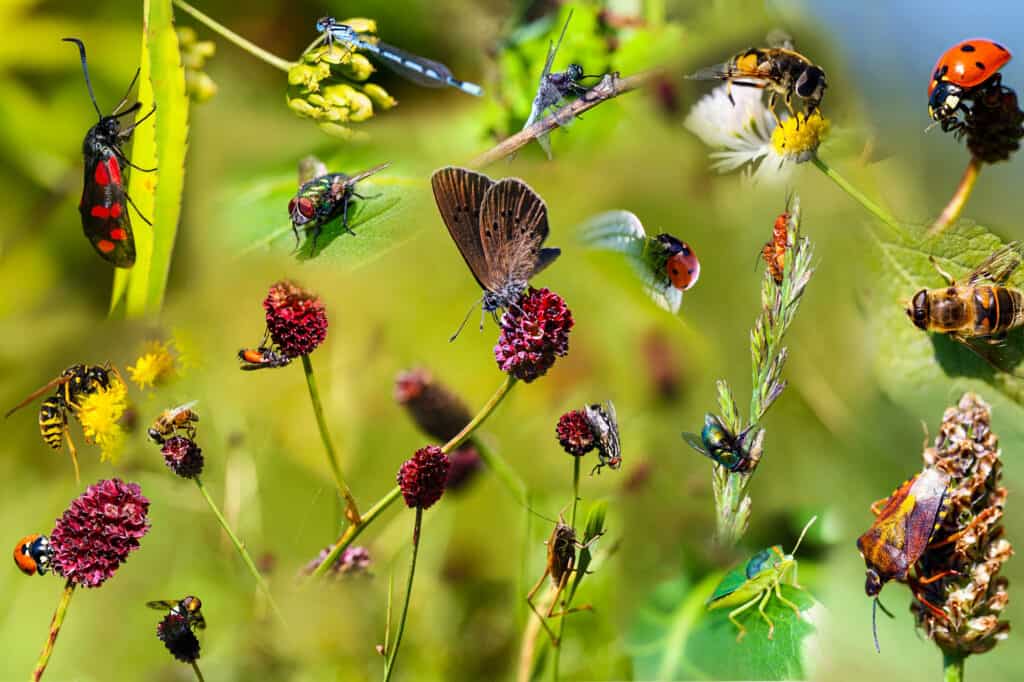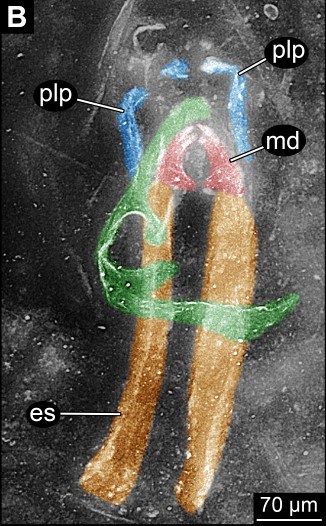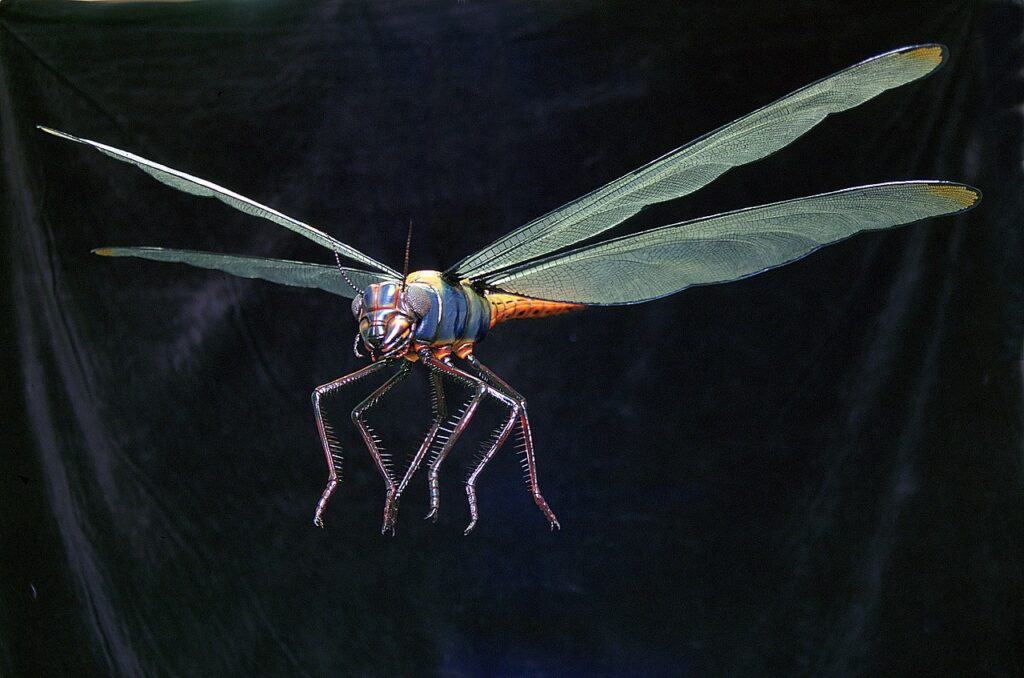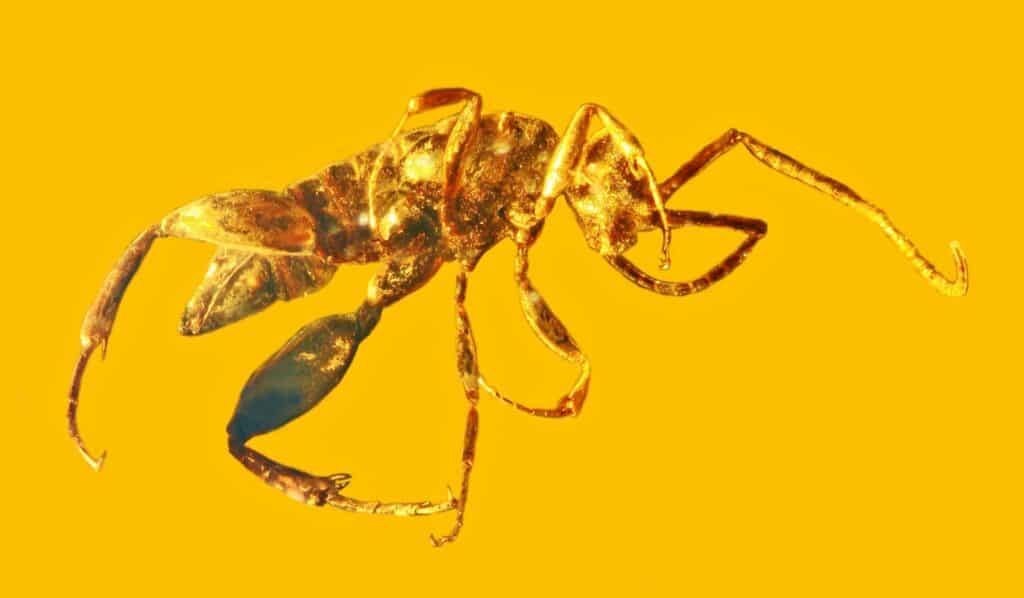You may not even notice how many insects you see each day. They’re inescapable and everyone on Earth has interacted with them. Insects are incredibly diverse and come in all different shapes and sizes; from the Goliath beetles in central Africa to the tiny fruit flies we swat at upon reflex, they are everywhere. Have you ever wondered if it has always been this way? Are the fascinating creepy crawlers we find today the same as the ones that were buzzing around millions of years ago? Let’s find out! This article will explore how long insects have been around and why some have gone extinct. Then we’ll take a closer look at 3 extinct insect species!
What are Insects?

Insects are invertebrates.
©iStock.com/Andreas Häuslbetz
Insects are invertebrate animals that have a broad distribution around the world. They are the most species-rich class of arthropods alive today. Arthropods are a group of invertebrates distinct by their exoskeletons, segmented bodies, and jointed limbs. Some living arthropods are lobsters, crawfish, arachnids including spiders and scorpions, and many others.
Insects have three body segments with a specific type of exoskeleton, three pairs of jointed legs, compound eyes, and one pair of antennae. Some types of insects are bumblebees, ants, flies, ladybugs, and thousands of others. The most abundant insects on earth are ants- up to 100,000 trillion ants are out and about any given day!
When, How, and Why have Insects gone extinct in the past?
Insect origin and history
Insects first appear in the fossil record about 400million years ago! For perspective, the early human species date back to only 6 million years ago. There are currently more than about 5.5 million species of insects alive on Earth but millions more have inhabited this planet over hundreds of millions of years. Insects live on all seven continents and are critical to the survival of every terrestrial ecosystem in some capacity.
While insects are abundant on Earth now, this has not always been the case. There is a gap in the fossil record around 385 to 325 million years ago known as the arthropod gap or the hexapod gap. Archaeologists have recovered no arthropod fossils from this period. It is not entirely agreed upon as to why this is.
Some scientists suggest that there was an abundance of insect life on Earth during this time. The reason they don’t appear in the fossil record is simply due to the rock material that was prevalent then. Scientists suggest it may have been poorly suited for preservation and as a result, few fossils can be found intact today.
An alternative hypothesis is that low atmospheric oxygen levels had adverse effects on arthropod species and caused a mass extinction event. This theory suggests there are no fossils dating to this period because the organisms were not alive then. This theory, however, has become less popular with the discovery of recent scientific evidence.
Extinction
Extinction events occurring over the millennia have affected many insect species. Paleoecologists, archaeologists, and other scientists work together to theorize why these events happen and are still attempting to answer persisting questions and new questions every day.
A particular point of interest in current research is the changing prehistoric climate and atmospheric conditions. For example, the Quaternary extinction event, which was most intense during the Late Pleistocene, was potentially a result of climatic factors. Rapid warming of the Earth’s atmosphere caused many large mammal species to go extinct including the woolly mammoth, the short-faced bear, and the dire wolf. Several extinct insect species were also casualties of this event.
Another major decline in biodiversity was the K-T extinction event, also known as the Cretaceous-Paleogene extinction event, 66 million years ago. During this time, many animal and plant species became extinct. In fact, three-quarters of all plant and animal species on Earth were wiped out! Many insect species were extinct during this event as well. Scientists have widely accepted evidence that the cause of this event was a massive asteroid impact.
With some background on the history of insects in mind, let’s meet 3 cool extinct insect species!
1. Rhyniognatha hirsti

likely gave rise to other insect species.
©Carolin Haug, Joachim T. Haug / CC BY 4.0 – License
The first cool extinct insect species is Rhyniognatha hirsti. This is arguably the first insect species ever, dating back to approximately 400 million years ago! During this time, the first terrestrial ecosystems were beginning to form and plants first emerged on land around 500 million years ago. When insects descended from crustaceans, potentially beginning with Rhyniognatha hirsti, their relationship with plants and their subsequent coevolution has been incredibly important to all life on Earth.
As the possible first insect, Rhyniognatha hirsti likely gave rise to all other insect species. A large variety of insects have extremely influential relationships with many different plants, so insects in many ways are responsible in part for the evolution of numerous highly diverse plants as well. The evolution of this one animal was potentially a key component of the evolution of life on Earth.
Description
The first fossil of this cool extinct insect species was discovered in 1919. The fossil was of mouthparts that later analysis claimed closely resembled that of a mayfly. Rhyniognatha hirsti is also thought to have had wings. Scientists predict that it was capable of flight; in fact, insects were the first animals in the world to take to the air! This pioneering insect was likely also a larval insect, meaning during development it underwent a metamorphosis from a larva into an adult.
Some contend that Rhyniognatha is not an insect but a prehistoric species of myriapod. Specifically, some consider it to be a type of centipede.
2. The Griffinfly (Meganeuropsis permiana)

Griffinfly is the largest insect ever discovered.
©Werner Kraus / CC BY-SA 4.0 – License
The second fascinating extinct insect species to investigate is the griffinfly (Meganeuropsis permiana). This massive insect was first discovered in 1939 in present-day Elmo, Kansas. A second species of the same genus has also been described, Meganeuropsis americana. This specimen was found in Noble, Oklahoma in 1940.
The griffinfly is thought to have been alive between 290.1 and 283.5 million years ago during the Artinskian age of the Permian period. Just before this time, there was a “carboniferous” period where atmospheric carbon dioxide levels decreased drastically, and oxygen levels increased in response. Some scientists speculate this enabled the griffinfly to evolve its tremendous size. Insects are typically limited in growth potential by oxygen availability and the rate of oxygen diffusion in their bodies. More oxygen in the atmosphere might have let insects during this time to achieve greater sizes. When the atmosphere shifted again many years later and oxygen concentration was decreasing, the large insect species could no longer survive.
Description
As mentioned, griffinflies were very big. But just how big were they?
Amazingly, the griffinfly species Meganeuropsis permiana is the largest insect ever discovered! It resembled a dragonfly, except its wingspan was about nine times bigger than the common green darner we often see today. The griffinfly had a wingspan of up to 28 inches- similar to the wingspans of two Baltimore orioles! Its body length was up to a massive 17 inches, as well.
3. Aptenoperissus bumanicus

was a parasitic wasp.
©Oregon State University / CC BY-SA 2.0 – License
The third, thrilling, terrific, and terrifying extinct insect species to discuss is Aptenoperissus bumanicus. This ancient species was a parasitic wasp that was alive between 100.5 and 93.9 million years ago during the Late Cretaceous Epoch. This species was only discovered recently in 2016! A group of scientists at Oregon State University analyzed the first specimen which was preserved in a chunk of amber around 100 million years old. It was found in Myanmar in southern Asia.
There are eight species of parasitic wasps in the genus Aptenoperissus. All 8 species are now extinct; however, this genus belongs to the superfamily Stephanoidea which includes a group of parasitic wasps that are alive today. The family Stephanidae, crown wasps, includes 345 living species.
Description
Aptenoperissus bumanicus was a very interesting-looking insect. It resembled a wasp, mixed with an ant, that also had some characteristics of a grasshopper. It had long legs that gave it impressive jumping abilities. Scientists believe they were wingless, unlike their modern wasp relatives, and that they had a strong stinger. The preservation of the wasp in amber allowed for a uniquely thorough investigation as compared to what can usually be gleaned from stone fossils.
The photo featured at the top of this post is © Werner Kraus / CC BY-SA 4.0 – License / Original
Thank you for reading! Have some feedback for us? Contact the AZ Animals editorial team.






